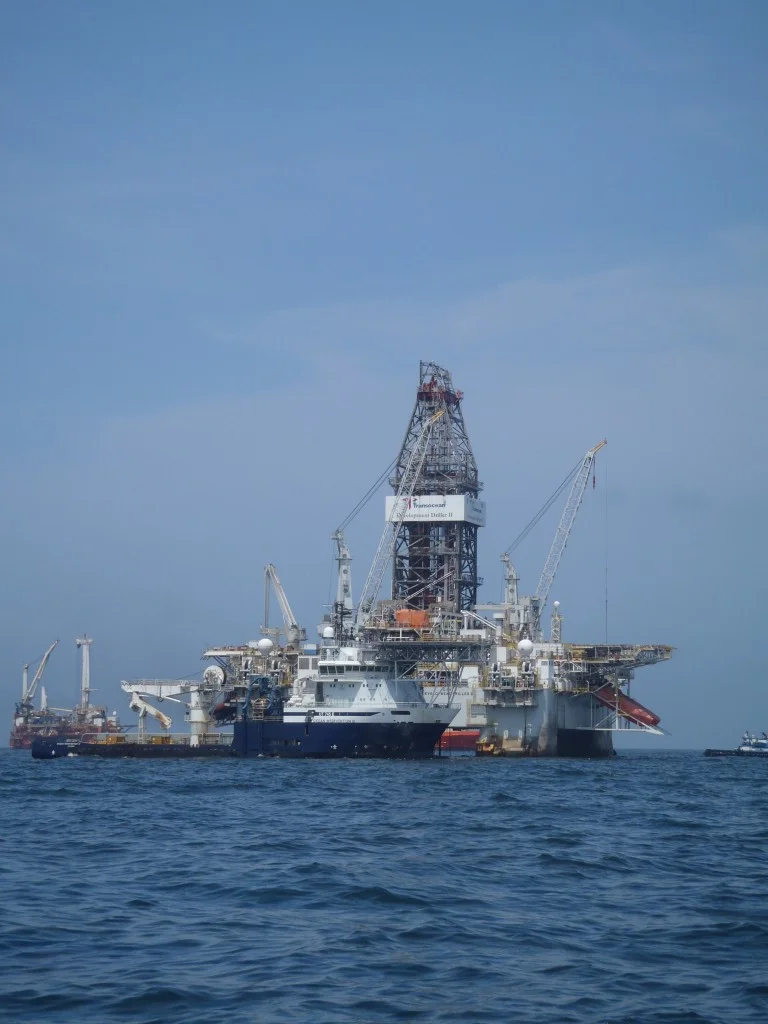The plume was hiding. We anticipated that the flow trajectory of the oil and gas discharging from the leaking riser pipe would change after the pipe was cut but it was tough to predict which way the flow would go. We had a day and a half of ops remaining and our goal was to find the plume, revisit several stations to see how they had changed over time, and sample two control sites well away from the plume.
Discoverer Enterprise methane flare
When we arrived back at ground zero, things had changed. The Discoverer Enterprise was sporting a methane flare. This is how drilling ships and rigs get rid of excess methane gas—they burn it. The flare was visible from several miles away and when we were up close, about 0.75 miles away, the roar of the flame was audible. Several fire control boats were dousing the flare pipe and the area around it with water to keep it as cool as possible. The sound of the burning flame was mesmerizing and we spent some time taking in the sight. We found the plume after about 8 (very frustrating) hours of searching for it. The weather was windy and rainy; the seas were unsettled; visibility was limited. The Discoverer Enterprise was about 1.5 miles away from us but you could barely see it through the rain. The dreary conditions mirrored how I felt after spending 8 hours trying to find something I knew was there. I thought the plume had moved to the east but it turned out that it had moved south. So much for intuition!
Drill ship with flare through the rain.
In the end, all was well because we found it. We wanted to have plume samples after the riser was cut so we could compare them to those collected before it was cut. We collected samples of the plume waters near the spill site and of the waters above and below the plume. Then, we moved on to re-occupy some stations we visited during our first three days of operations with the goal of determining how things had changed over a week. We have three stations remaining to sample and will head back to Gulfport about 10PM this evening. We should be in tomorrow afternoon. During this cruise, we sampled 79 stations and conducted 89 CTD casts. Over the coming weeks, we’ll be analyzing samples, running lab experiments and pulling all the data together to see what stories they tell.
Oily surface sheen
Below, I’ll do my best to answer some of the questions I have received in the past few days. The questions are in bold (I’ve shortened some of them); my answers are in regular font.
Is the oil:dispersant mixture in micellar form? Or is the oil in droplets?
The answer is both. It’s likely that some of the oil-dispersant mixture is present as micelles but there are also oil droplets in some of the samples, especially those from near the leaking riser pipe. There is a lot of light scattering in the plumes, this could be due to several factors, including the presence of oil in the water.
Re: sulfonate detergent micelles: what effect does this ionic packaging have on accessibility to the oil of bacteria doing the bioremediation?
Unfortunately, no one knows the answer to this question and it is a KEY question that we need to know the answer to.
Iron depletion appears to be a limiting factor in growth of algae in seawater. Is it known whether this, or some other limitation, will restrict bacterial degradation of the oil?
Oddly enough, there could be a good bit of iron coming out of this leaking well. We have not measured total Fe content but others have told me that there is a lot of iron [Fe(III)] in the water. So, iron concentrations could be elevated around the spill site.
Why can't they implode the well like they did during the Gulf War?
That is not really an option in this situation. This reservoir is extremely methane rich and detonating a blast would lead to major destruction and destabilization of a significant area of the slope in the vicinity of MC252. In my opinion, this option is far too dangerous to be seriously considered.
eep Driller II (DD2 for short) is drilling one of the relief wells.
How serious is the oxygen depletion problem?
Potentially, this is a very serious problem. At present, oxygen concentrations exceed 2 mg/L but if concentrations drop below that, it would spell problems for any oxygen requiring organisms. The Southwest Plume is, at a minimum, 15 miles long x 2 miles long and the plume is about 600 feet thick. Temperatures in the plume are about 8-12ºC. We do not know the absolute oil content at this time. The plume is largely water. This is not thick oil like you see on the surface in some places, it’s diluted oil and it’s most concentrated closest to the leaking riser pipe. Unlike a natural oil seep, which is most intense on the bottom and whose signal decreases with depth above the seafloor, the plume we are studying starts 200m above the seafloor and its intensity decreases horizontally with distance away from the leaking wellhead. The specific gravity of oil is irrelevant to this discussion. This is not oil like you buy at the auto supply store. Think of it as gas-saturated oil that has been shot out of a deep sea cannon under intense pressure – it’s like putting olive oil in a spray can, pressurizing it and pushing the spray button. What comes out when you push that button? A mist of olive oil. This well is leaking a mist of oil that is settling out in the deep sea.
How much biodegredation appears to being observed for the oil plumes?
There is a tremendous amount of oxygen consumption in the plumes. We have measured respiration rates in the plumes, above and below the plumes, and at control sites where plumes are not present. The respiration rates in the plume are at least 5-10 times higher than we see anywhere else.
Are the conditions good for the microbes that can degrade these types of hydrocarbons?
Right now, conditions seem to be ideal for microbial degradation. But we need to do additional lab experiments to figure out what is regulating microbial activity.
Are the concentrations of the hydrocarbons so great that the microbes are overwhelmed or killed?
We have not yet measured toxicity but we plan to do that when we get back to the lab at UGA.





